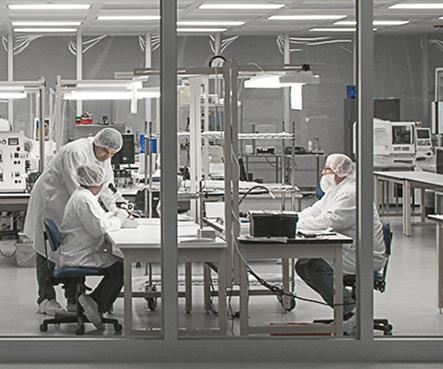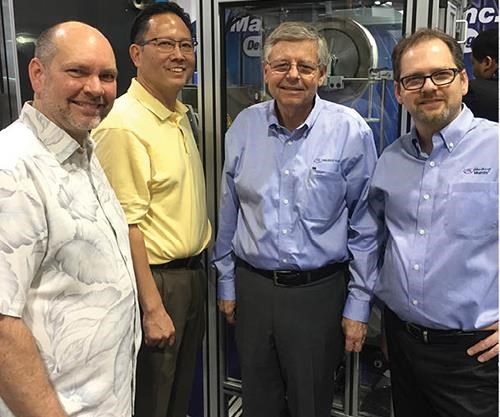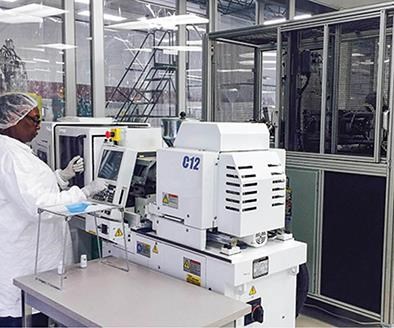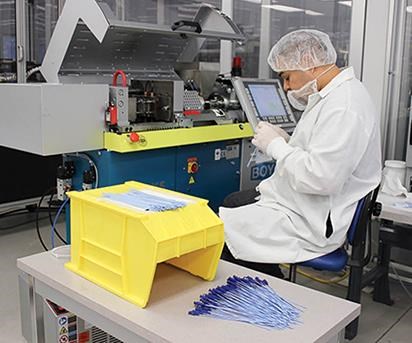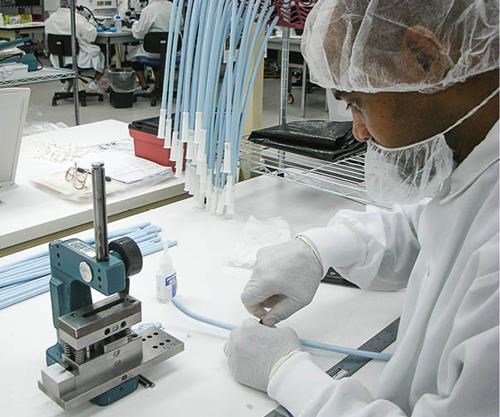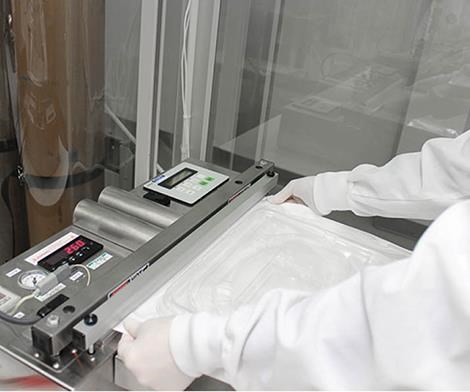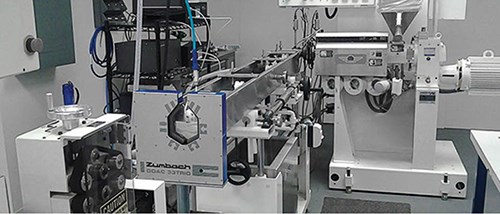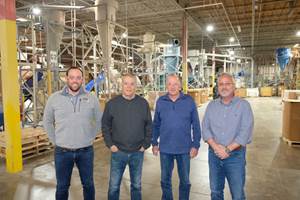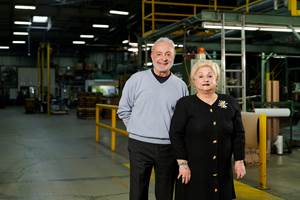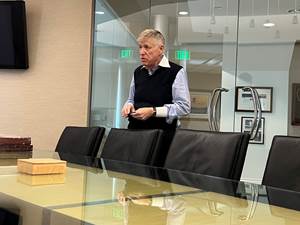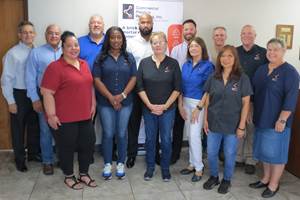Collaboration in Catheters
Medical Murray has developed innovative catheter technologies by working with its customers and down its supply chain.
The company first opened its doors on April Fool’s day 20 years ago, but its success has been anything but a joke. In fact, it’s the result of a collaborative effort. As a leading supplier of complete catheter systems for medical-device suppliers, Medical Murray has found that positioning itself between its OEM customers and its tubing processors has fueled the development of innovative products and yielded double-digit growth from year one.
Headquartered in North Barrington, Ill., Medical Murray Inc. is still owned by its founders, the Leopold family. Andy Leopold, v.p. of research and development, had spent more than 10 years in the catheter business with a firm on the West Coast before partnering with his father Phil to launch the company.
The older Murray, described by his son as “a Nebraska farm boy who didn’t like farming,” came to the company with a Bachelor’s degree in mechanical engineering and a Master’s in metallurgy from the University of Nebraska. Phil Leopold started his career with a composites company, where he was involved in groundbreaking developments in golf shafts and tennis rackets, among other things. The Leopold patriarch also launched a U.S. subsidiary for Swiss-based Bucher, which at the time made injection molding and injection-compression machines.
Andy Leopold’s background is in biomedical engineering, but with a specialty in vascular catheters. His prior work experience in R&D for Advanced Cardiovascular Systems (ACS) put him on the ground floor of breakthrough developments in angioplasty catheters, luers, and other devices. He notes, “My history is in developing long, skinny things that go into vessels. I dragged my dad into the medical world, but his strength in materials and processing has made for a great fit.”
Andy’s younger brother, Eric Leopold, is also a biomedical engineer with a Master’s degree in materials engineering. Like his brother, he worked at ACS. In 2014 Eric joined the family business and opened a satellite development office in California.
The company was launched as Murray Company in recognition of the elder Leopold’s middle name (his mother’s maiden name). While most firms like to talk about being customer-focused, Medical Murray can put its money—or at least its company name—where its mouth is. Recalls Andy, “One day early on we had a customer call in and ask ‘Is this the medical Murray company?’ We thought that sounded cool so we changed our name.”
Today, the company is a specialist in designing, developing, and contract manufacturing unique medical catheter systems, permanent implants, and intricate components for less invasive vascular, urologic, and surgical applications. About 90% of its business is domestic, though Medical Murray has done development work on projects knowing up front that manufacturing will be transferred overseas. And the company has met its day-one goal of growing by at least 10%/yr since it started up. “When you’re a company like us that focuses so much on the development side, it’s tough to grow faster than that,” says Andy Leopold.
In 2014, company sales grew an astonishing 50%. “That happened because we were able to get wider and deeper into our current customer base,” explains Paul Imaoka, v.p. operations. “And we continuously add capabilities that provide value to the full device to further embed ourselves with existing customers.”
TWO-WAY COLLABORATION
The focus of the company today, says Andy Leopold, is medical and only medical. More specifically, he adds, “We do everything it takes to build a catheter except extrusion.” This includes making laminated composite tubes with low-friction liners and providing value-added services such as braiding, adding longitudinal reinforcements, radiopaque markers, special tips, and formed tips.
Medical Murray does in-house injection molding of luers onto catheters and over-molded transitions from multi-lumen tubes to a single lumen. It relies on a small group of extrusion processors to supply tubing, and has no immediate plans of getting into extrusion.
Typically, a complete catheter may consist of anywhere from four to 10 different extruded tubes, Leopold explains. These can all be made of different materials, in different durometers, in different diameters, and with various numbers of lumens.
“With all the size ranges of tubing that we use (from 2 french, or 0.67-mm OD, to 30 french, or 10-mm OD), and the wide range of materials we use, we’d need about six extruders to make tubing on our own,” says Leopold. “That would be a huge undertaking, so we opt to buy tubing and focus on adding value and components in order to furnish a complete system. We’d rather rely on a small group of extrusion specialists to support us. Their quality systems are routinely reviewed and only those that can meet our standards are used for supply of our production components.”
So that makes collaboration with its medical-tubing processors critical. Says Leopold, “Customers stress collaborative efforts not only between us and them, but between us and our supply chain.” What does Medical Murray look for in an extrusion processor? According to Leopold, the ability to hold tolerances is number one on the list. “With the assembly we do—we are always placing components down the lumen—tolerances are hugely critical. That makes or breaks our ability to make a device. And we’ve found that the single biggest challenge in extruding medical tubing is maintaining tolerances. Sometimes the dimensions don’t work. So we might ask a supplier to challenge load a 5-ft-long mandrel down the lumen to make sure it’s going to work for certain applications.”
Medical Murray also needs its extrusion supplier to be able to go quickly from a development tube to steady-state manufacturing with reliable quality and delivery. The supplier also should have in-house tooling capabilities (see sidebar below for details on processor with which Medical Murray works).
Medical Murray and its tubing suppliers often work collaboratively on design. Says Leopold, “Often we’ll get feedback from a customer and may determine, for example, that if we change the lumen shape from round to asymmentrical it will hold critical tolerances better. One project started with a five-lumen design and ended with a nine-lumen tube to make for a better overall catheter. It’s important that our suppliers be able to react quickly and make the tooling.”
The outgoing products from tubing suppliers influence what Medical Murray has to do on its end, and discussions with its supply side are ongoing. Leopold explains: “Is it better for us to do a secondary process, or is it better for us to work with an extruder who can provide us with bump tube? Should we change materials in some way? Should we bond tubes of different materials or durometers, or are we better off altering materials so that we get different performance across the length of the tube? Do we look for an extrusion with a braid or coil, or do we add those features in a secondary step? We have those discussions, and consistently ask ourselves, ‘What is the best way to get what we need at the end?’”
North Barrington also houses much of Medical Murray’s R&D operation. That encompasses design, prototyping, catheter development, materials evaluation, testing, and pilot production. Most projects trace their roots here, and customers range from Fortune 50 companies to local doctors who have an idea for a better mousetrap. Collaboration is critical here, too. States Leopold, “Our customer base encompasses a huge range. We’ll work with an individual doctor who might come to us with nothing more than an idea on what a device might look like to treat a particular disease. And of course we’ll work with larger companies, who tend to bring us technical challenges related to materials or processing that test even the brightest, most experienced engineer.”
Whether the customer is big or small, the next step in Medical Murray’s process is to collaborate, starting with designing and building working prototypes. “We use rapid prototyping and pull from years of experience for these jobs. We also have weekly meetings with customers in which we go through what we learned, what the next steps are, and what changes are needed in the original design,” says Leopold.
The company also benefits from full-service design and development facilities in Charlotte, N.C., and San Carlos, Calif. “We carry a huge inventory of components in our labs and have extensive equipment capabilities, like a Santa’s Workshop for catheters,” states Leopold. “About 60% of the equipment we use in our labs is built internally. Of course we’ll buy things like hot-air boxes, laminators, welding equipment, and plasma-treating equipment; but for really unique projects we’ll design and build the equipment ourselves.
“One project had a series of formed nitinol wires that we were overmolding in a tiny mold,” recalls Leopold. “We made a fully automated machine that cut the wires to length and heat-set them before molding. In another instance we had to provide tipping for a Pebax TPE catheter that ranged from 3 french to 27 french, with a series of different sizes in between. At the bigger sizes, standard tipping methods didn’t work—there was too much plastic to heat and move—so we built our own tipper for the thick-walled tubes.”
Back around the turn of the 21st Century, this home-made machinery initiative even led Medical Murray to build its own injection molding machines. The Sesame micromolding machines, which the company still operates, were designed for precision parts from 0.0004 to 0.40 in.² area and weighing as little as 0.0001 g. Recalls Leopold, “We wanted to offer the ability to mold junctions from one multi-lumen tube to another with different durometers. Mostly all of this kind of work was being done by hand with razor blades and fixtures and hot boxes. But we wanted to mold those features directly onto the catheter, and we built a micromolding machine for that purpose.” The small-shot Sesame machines allow very high-cost materials to be molded with minimal material loss. “We spent a few years promoting this machine, but soon enough we realized that we’d be better off focusing on making plastic parts, not machinery.” The Sesame molding technology has since been licensed to Lawton Machinery Group, De Pere, Wis.
AGILE MANUFACTURING
Given the frequent changes in medical products, it helps that Medical Murray employs what it calls “agile” methods of manufacturing. “The term comes from the software world and emphasizes handling change and incorporating it into your culture,” Leopold explains. “In our business, change is inevitable. Most businesses almost never hear the full story from their customers. For us, agile manufacturing is an approach where we try to learn issues that are critical to customers up front to the extent possible, and then adapt quickly as they change.”
Medical Murray’s manufacturing facility is in Lake Zurich, Ill., about 10 miles away from the North Barrington headquarters. There, says Imaoka, Medical Murray has 20,000 ft² of manufacturing space that includes a 6000 ft² ISO Class 7 clean room. The firm’s own Sesame presses and those furnished by others are used to insert-mold components for catheters and other applications. These include marker bands insert molded into catheter tips, radiopaque metal/urethane insert-molded tips, multi-material molded components, and bioabsorbable staples and fasteners. Medical Murray also overmolds luers on extruded tubing in its clean room. Manufacturing operations include complete assembly, packaging and sterilization, distribution and logistics.
In Lake Zurich, 65 people are currently employed in two shifts, Imaoka says. The company generates 170 different SKUs. “Medical Murray primarily uses thermoplastic elastomers from 10 different suppliers in virtually every durometer range and we formulate different additives for x-ray visibility and color,” says Imaoka. “We also regularly use PET, nylon, polyimides, ABS, and silicone rubber for handles, packaging, and balloons.”
Related Content
Evolving Opportunities for Ambitious Plastics Recycler
St. Joseph Plastics grew from a simple grinding operation and now pursues growing markets in recycled PP, food-grade recycled materials, and customized post-industrial and post-consumer compounds.
Read MoreGeneration Gap? Not at Packaging Personified
Started at a kitchen table and now in its third-generation of family involvement, this vertically integrated supplier of flexible packaging traces its success to closely aligning with customers and continually investing in new technology across its films, printing and converting operations.
Read MoreUS Merchants Makes its Mark in Injection Molding
In less than a decade in injection molding, US Merchants has acquired hundreds of machines spread across facilities in California, Texas, Virginia and Arizona, with even more growth coming.
Read MoreInside the Florida Recycler Taking on NPE’s 100% Scrap Reuse Goal
Hundreds of tons of demonstration products will be created this week. Commercial Plastics Recycling is striving to recycle ALL of it.
Read MoreRead Next
Beyond Prototypes: 8 Ways the Plastics Industry Is Using 3D Printing
Plastics processors are finding applications for 3D printing around the plant and across the supply chain. Here are 8 examples to look for at NPE2024.
Read MorePeople 4.0 – How to Get Buy-In from Your Staff for Industry 4.0 Systems
Implementing a production monitoring system as the foundation of a ‘smart factory’ is about integrating people with new technology as much as it is about integrating machines and computers. Here are tips from a company that has gone through the process.
Read More

